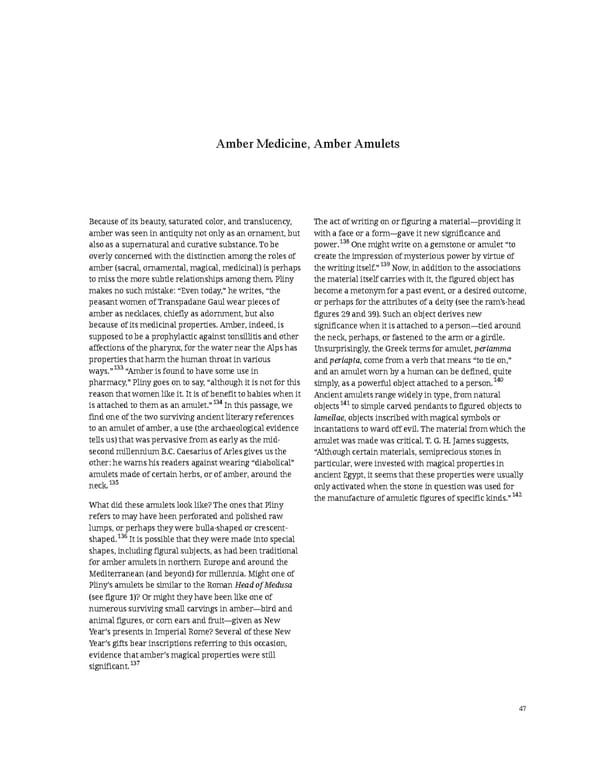Amber Medicine, Amber Amulets Because of its beauty, saturated color, and translucency, The act of writing on or figuring a material—providing it amber was seen in antiquity not only as an ornament, but with a face or a form—gave it new significance and also as a supernatural and curative substance. To be power.138 One might write on a gemstone or amulet “to overly concerned with the distinction among the roles of create the impression of mysterious power by virtue of amber (sacral, ornamental, magical, medicinal) is perhaps the writing itself.”139 Now, in addition to the associations to miss the more subtle relationships among them. Pliny the material itself carries with it, the figured object has makes no such mistake: “Even today,” he writes, “the become a metonym for a past event, or a desired outcome, peasant women of Transpadane Gaul wear pieces of or perhaps for the attributes of a deity (see the ram’s-head amber as necklaces, chiefly as adornment, but also figures 29 and 39). Such an object derives new because of its medicinal properties. Amber, indeed, is significance when it is attached to a person—tied around supposed to be a prophylactic against tonsillitis and other the neck, perhaps, or fastened to the arm or a girdle. affections of the pharynx, for the water near the Alps has Unsurprisingly, the Greek terms for amulet, periamma properties that harm the human throat in various andperiapta, come from a verb that means “to tie on,” ways.”133 “Amber is found to have some use in and an amulet worn by a human can be defined, quite pharmacy,” Pliny goes on to say, “although it is not for this simply, as a powerful object attached to a person.140 reason that women like it. It is of benefit to babies when it Ancient amulets range widely in type, from natural is attached to them as an amulet.”134 In this passage, we objects141 to simple carved pendants to figured objects to find one of the two surviving ancient literary references lamellae, objects inscribed with magical symbols or to an amulet of amber, a use (the archaeological evidence incantations to ward off evil. The material from which the tells us) that was pervasive from as early as the mid- amulet was made was critical. T. G. H. James suggests, second millennium B.C. Caesarius of Arles gives us the “Although certain materials, semiprecious stones in other: he warns his readers against wearing “diabolical” particular, were invested with magical properties in amulets made of certain herbs, or of amber, around the ancient Egypt, it seems that these properties were usually neck.135 only activated when the stone in question was used for the manufacture of amuletic figures of specific kinds.”142 What did these amulets look like? The ones that Pliny refers to may have been perforated and polished raw lumps, or perhaps they were bulla-shaped or crescent- shaped.136 It is possible that they were made into special shapes, including figural subjects, as had been traditional for amber amulets in northern Europe and around the Mediterranean (and beyond) for millennia. Might one of Pliny’s amulets be similar to the Roman Head of Medusa (see figure 1)? Or might they have been like one of numerous surviving small carvings in amber—bird and animal figures, or corn ears and fruit—given as New Year’s presents in Imperial Rome? Several of these New Year’s gifts bear inscriptions referring to this occasion, evidence that amber’s magical properties were still significant.137 47
 Ancient Carved Ambers in the J. Paul Getty Museum Page 56 Page 58
Ancient Carved Ambers in the J. Paul Getty Museum Page 56 Page 58
